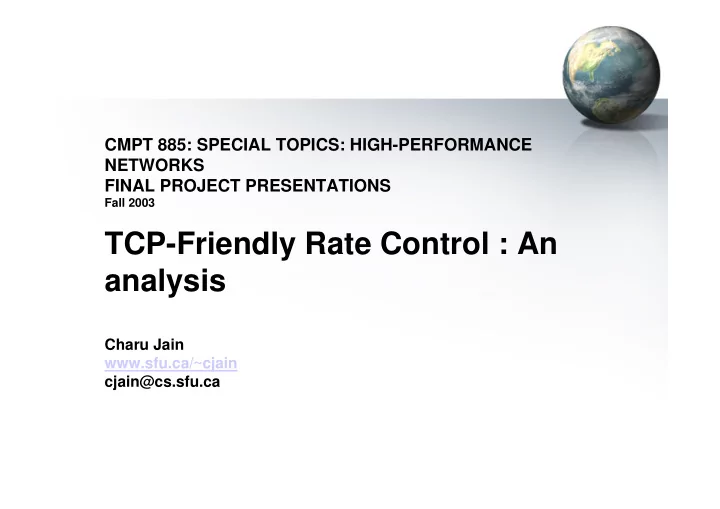

CMPT 885: SPECIAL TOPICS: HIGH-PERFORMANCE NETWORKS FINAL PROJECT PRESENTATIONS Fall 2003 TCP-Friendly Rate Control : An analysis Charu Jain www.sfu.ca/~cjain cjain@cs.sfu.ca
Roadmap • Introduction • Ongoing Work • Problem Statement • Goal • My work • Results and Conclusion • References
Introduction • Network Congestion and growth in the number of Multimedia Applications • UDP is unresponsive to congestion – Starvation of TCP traffic – Congestion collapse
Ongoing work : An Update • End-to-End Vs. Active core debate • TCP congestion ctrl. , TFRC, TFRC-PS (still an abstract concept) • DCCP : UDP plus Congestion Control • RED-PD (under development) is a flow-based mechanism that keeps state for just the high-bandwidth flows. RED-PD uses the packet drop history at the router to detect high- bandwidth flows in times of congestion and preferentially drop packets from these flows. • ECN
Problem Statement • For some applications such as Internet Telephony, it is more natural to adjust packet size while keeping the packet rate as constant as possible. • Many VoIP applications use 20-30 ms packets despite low payload efficiency, in order to keep end-to-end delay lower than 150 ms. • Rate varying congestion control mechanisms are NOT suitable for Internet Telephony.
Goal • To devise and implement a simplified protocol that is suitable for VOIP-like applications and at the same time responds constructively to Congestion.
Why can’t TFRC work for VoIP? • TFRC is a congestion control mechanism designed for unicast flows operating in an Internet environment and competing with TCP traffic • TFRC is a receiver-based mechanism, with the calculation of the congestion control information in the data receiver rather in the data sender. • Documented in RFC 3448, by M. Handley, S. Floyd, J. Padhye, J. Widmer • Category: Standards Track, Released January 2003
Protocol Mechanism Receiver Sender sends measures at rate X lost event rate p Sender updates X Receiver sends using p and RTT feedback Sender measures RTT
• There is a clear tradeoff between payload efficiency (payload/total packet size) and packetization delay (time to fill a packet), and one way to increase bandwidth efficiency would be to accumulate many audio frames within the same packet. VoIP apps prefer to use small packets • Thus, audio sources typically generate packets at a constant rate and perform congestion control by switching codecs, which has the effect of varying their packet size • Other applications may be driven to adjust the packet size independently of congestion control (for example: a high bit error rate in a wireless environment induces a small packet size). • Such applications have a variable packet size and simply adjusting their packet rate as though packets were path-MTU-sized is clearly not fair.
• What happens when a rate-control mechanism like TFRC is used for an application that uses variable pktSizes? • Similar to TCP, where commonly only one window reduction per congestion window is possible, a loss event is defined as one or more packets lost during one RTT (i.e., packet loss during an RTT is aggregated to a single loss event). Using the reference packet size in the equation results in a higher packet rate. • The higher the number of packets per RTT, the more likely it is that multiple lost packets will be aggregated to a single loss event and the average number of loss events per packet will decrease, resulting in a strong bias in favor of sending small packets at a high rate.
Packet-Size Scaling Protocol (PSP) • VoIP data packets ↔ RTP ↔ UDP ↔ IP I,II layers • Modifications at the transport layer • Simple N-level packet size scaling mechanism
Protocol Mechanism Receiver Sender sends Measures loss at constant rate X rate Sender Receiver modifies & sends modifies Scale_ every pktSize RTT
R n R 1 r2 Simulation Topology r1 S n S 1
TFRC PSP PSP
PSP TCP TCP alone
PSP TCP TCP Vs PSP
TFRC PSP TFRC Vs PSP
Conclusions • PSP is TCP-Friendly • It quickly achieves it’s fair share of Bandwidth. • No demands of high processing capacity at the receiver-end • It is suitable for applications that choose to maintain a high rate at the expense of reduced packet size.
• Optimum results were obtained when – PS_MAX ≤ MTU – Constant Rate, X ≤ (Bottleneck Bandwidth / PS_MAX) – PS_MIN ≥ PS_MAX / 4 • 1% packet loss due to congested queue at the router (with TCP)
Future work • A connection establishment phase, in order to automatically populate the “Preset packet-sizes” table and settle upon a an optimum constant transmission rate. These are important parameters in a Bandwidth limited environment to ensure a fair share of resources. • Study PSP behavior with RED-PD. • What compromises does a simplified mechanism like PSP entail? What applications can do away with it?
References • [1] S. Floyd and K. Fall, “Promoting the Use of End-to-end Congestion Control in the Internet,” IEEE/ACM Trans. Net. , vol. 7, no. 4, Aug. 1999, pp. 458–72. • [2] Widmer, J.; Denda, R.; Mauve, M.; “ A survey on TCP-friendly congestion control “ Network, IEEE , Volume:15 Issue:3, May-June 2001 Page(s): 28 -37 • [3] Ramakrishnan, K., Floyd, S. and D. Black, "The Addition of Explicit Congestion Notification (ECN) to IP", RFC 3168, September 2001. • [4] Balakrishnan, H., Rahul, H., and S. Seshan, "An Integrated Congestion Management Architecture for Internet Hosts," Proc. ACM SIGCOMM, Cambridge, MA, September 1999. • [5] Handley, M.; Floyd, S.; Padhye, J.; Widmer, J.; “TCP Friendly Protocol Specification (TFRC): Protocol Specification”; RFC 3448, January 2003. • [6] J. Padhye, J. Kurose, D. Towsley, and R. Koodli, "A model based TCP-friendly rate control protocol," in Proc. International Workshop on Network and Operating System Support for Digital Audio and Video (NOSSDAV), Basking Ridge, NJ, June 1999. 20 http://citeseer.nj.nec.com/padhye99model.html
• Interrogation • Cross-examination • Third degree
Recommend
More recommend